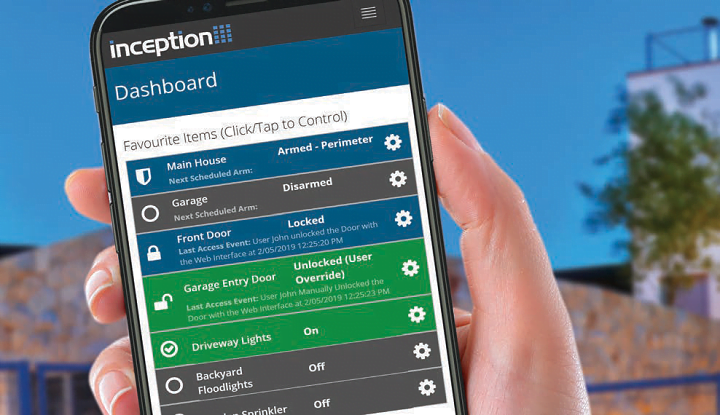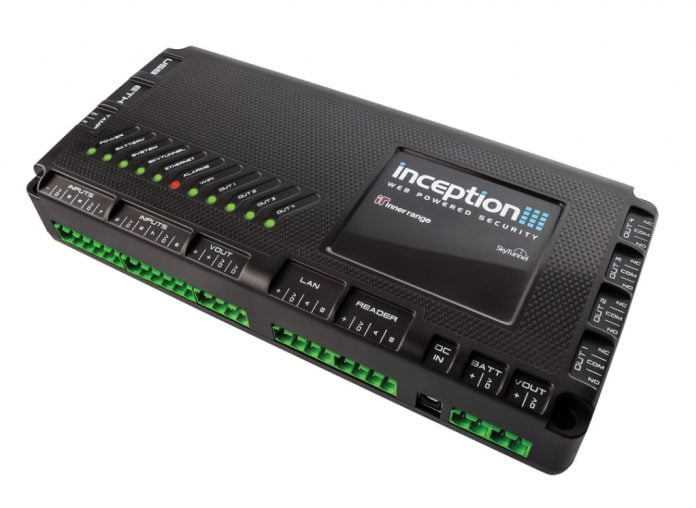Steve Mitchel explains the development of the Inner Range Inception intruder, access control and automation panel.
Q: Who had the idea to build the Inception intruder and access control panel?
SM: There was definitely a shift in the SME market away from the complexity of on-premises software, so we felt the time was right for a browser-based access control product.
Q: When you started the Inception project, what was your goal?
SM: The Inception project aimed to create a new integrated intruder and access control platform with a focus on simplicity and ease of use. We wanted a product that was easy for everyone, easy for integrators to install and maintain, easy for customers to use day-to-day, easy for support to assist with, easy for Sales to sell and easy for non-Inner Range integrators to learn.
Q: What UX design techniques did you use?
SM: From the very beginning it was my intention to create a product which was easy for both integrators and end users. The aim was to have a responsive interface. There are only so many ways to unlock a door or detect an intruder, so I placed more emphasis on the usability of the product.
Integrators desire faster and easier installs, an intuitive user interface for both themselves and the end-user, a reliable product without a large maintenance burden, but still enough flexibility to tailor the solution to the customer’s needs.
We chose to use bootstrap, so that the user interface would work on a computer, on a laptop, on a tablet, on a phone. It would work well on any interface. Bootstrap had only been recently released when development for Inception begun and at that stage was a very innovate framework to base the user interface on.
Q: What are some user friendly features that are unique to Inception?
SM: About 7 years ago development of Inception began with the attempt to condense the company’s decades of industry experience into one product. Staff from all departments were involved, especially the customer-facing staff in tech support and sales, to work out not only what a feature was used for in traditional intruder and access control, but why they were used.
This helped ensure Inception lined up with how our customers actually used our products, not just how R&D thinks they are used. Feedback, suggestions, and annoyances that had been received over the years were incorporated and addressed where possible.
The result was a tailor-made solution for the small to medium commercial market space. A product requiring no software to install and configure, only a web browser on a computer or phone. An industry-first Commissioning Checklist was included to streamline the installation process and help ensure nothing was missed.
A suite of configuration options focused on everything needed for intruder and access control in the SME market, and a powerful automated action engine for flexibility. SkyTunnel connectivity for easy yet secure remote access to the web interface for the integrator and end-user, whether walking around site, at home, or on the side of the road.

Q: Tell us about the commissioning checklist?
SM: I wanted the checklist to make it easier and quicker for somebody to programme the system. First impressions count so the first time someone picked it up I wanted them to have the best experience possible. If they start from the beginning of the checklist and follow it to the end, they can be confident that they have fully programmed the intruder and access control system without missing anything. At the same time, they have also done it efficiently, without the backtracking or partially completing tasks.
Out of 2-and-a-half years of development, I spent a good 6 months of the development time in tech support learning all the issues that people were finding challenging with various access control products. I spent a lot of time in tech support because they obviously speak to the technicians directly and know how the technicians use products.
I wanted to learn about the commissioning process and what a technician commonly does once cables have been run and devices wired in. The technical support team are also very focused on the training side of things, so they know how the technicians are taught to use our products. I took all of this experience and used it when creating the checklist so that the technician could have the smoothest experience when programming Inception.
Q: How did you know that the market could accept a product which was very different to others on the market?
SM: There was a focus on usability testing from the right from the beginning of development. I started the process by understanding what the pain points were for users and structuring the product to solve those pain points. The usability testing had a significant impact on the final product.
I put together scenarios with instructions on what a hypothetical customer was looking for. I included a floor plan and answers to some questions which a tech would commonly ask a customer. I got people from R&D, tech support, non-technical people from sales, production, and administration to program the system. Based on their feedback I then refined the checklist.
I then took it to technicians outside of Inner Range and repeated the testing and then made further changes to ensure Inception was as easy as possible for the people who would be using and installing it.
Q: The release of the product was delayed for 6 months, why did that happen?
SM: The product was perfectly functional for 6 months, but I did not release it as I wanted to ensure things like installation and user manuals were as good as they could be. This even included the help tips which are embedded into the user interface. There are over 50,000 words worth of help text scattered throughout the pages.
If someone was taking the time to try Inception, I wanted the experience to be as good as possible. Technicians often stick with the product they know, and it is a large investment for a business to adopt a new hardware platform. So, the better that experience was, and the more benefits they could see compared to existing products, the more likely they would consider using Inception in future.
Q: When you were writing the help text what was your objective, 50,000 words of help text is significant in any product?
SM: A lot of the help text was to help the technician to understand the features and to reduce their need to call technical support for training related items. In the help text, I did not want to explain only what the option did. I wanted to explain what the feature was, why it was there, how you could use it, when you would use it and any other related information like ‘use of this would affect this other option’. I wanted to have all the information there.
If a tech did not know what the feature did there would be a couple of paragraphs of text to explain the feature to them in detail. Ideally, they would not need to call tech support to find out how something works because they have taught themselves.
The help text makes Inception accessible to customers from any background, such as an access control technician learning what an entry and exit path is, or an intruder technician incorporating disarm on access or three-badge arming into their solution.
Q: It’s common for access control and intruder systems to have an exposed PCB, however, Inception is encased in a plastic housing. Can you tell us why you did that?
SM: It was all about simplicity. Many access control systems with an exposed PCB can be overwhelming, you can see it and there are just components everywhere and it is hard for a technician to know what is relevant and what is not. There would be LEDs scattered around the board and connectors around the edge and on the board. You often need to scour the board to find what you are looking for.
To make it easy, a case is put over the top, so that all the noise is filtered out and you have got a clear instruction of the things which are relevant to a technician. USB, Ethernet, inputs all labelled, outputs all labelled, all the status LED’s in a row with clear naming. The product itself is a lot cleaner and easier to get going when compared to other products which had a lot of information which was irrelevant for the technician.

Inception Milestone XProtect integration.
Q: What is the future for Inception?
SM: From its initial release 4 years ago, market feedback and product sales indicate that Inception hit the mark with what it set out to do. Since then, Inception has enjoyed ongoing development as it is installed in more and more homes and businesses. Countless features continue to be incorporated into the solution based on suggestions from the market, letting Inception mature and grow as a product while still maintaining its simplicity.
Q: Can you tell us a bit about yourself and how you got into the access control industry, Steve?
SM: During my early years I had an interest in computers and was good at math, so I decided to study a double degree at Swinburne Uni which consisted of a Bachelor of Engineering (Electronics and Computer Systems), and a Bachelor of Science (Computer Science and Software Engineering).
As part of my degree, I completed industry-based learning in the access control industry, and loved the combination of technologies hardware, firmware and software, and have been in the industry ever since.
#sen.news









